|
Subpage flies:
Tachinidae
Blow-flies
(Calliphoridae) House
flies (Muscidae) Soldierflies
(Stratiomyidae)
Root-Maggot
Flies (Anthomyiidae)
Small
flies Small
flies Gnats
 Nederlands /
Dutch Nederlands /
Dutch
Flies, gnats
Diptera - two-winged. In this order belong all flies (Brachycera) and
gnats mosquitoes, crane flies, black flies, midges, long-horned flies (Nematocera).
In Dutch only two names Brachycera = vlieg and Nematocera =
mug. Much easier :-)
The second pair of wings has been changed into halteres at the Diptera (Club
shaped organs behind the wings).
Like all insects, the diptera have three pairs of legs. Fly larvae and gnats larvae have a complete
metamorphosis (egg - larva - pupa - adult).
Difference between fly (Brachycera) and gnat,... (Nematocera): Antenna of a fly consists of three segments. The antenna of a
gnat consists just like for example the antenna of a wasp of many segments. Sometimes they look like wasps, but they have four wings just like the other insects. |
Subpage gnats, ... (Nematocera) :
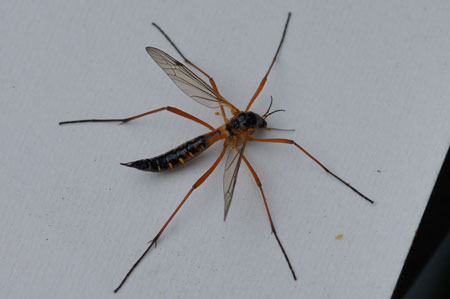 ... ... 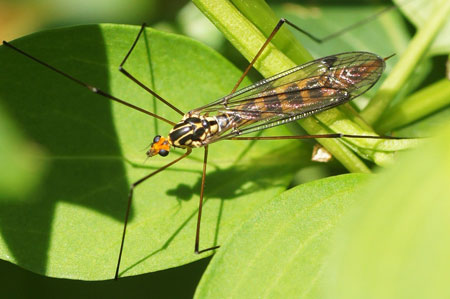
Ctenophora pectinicornis and Nephrotoma
flavipalpis. Family Crane flies (Tipulidae).
More information about gnats (Nematocera) you can find on Subpage
gnats
|
Flies:
Of some families I have many species. Those families, I've put on a subpage. Of each family is an example on this page. Below is a link to the subpage.
I also created a subpage with families, which consist mainly of small flies. Hover flies are on two separate pages.
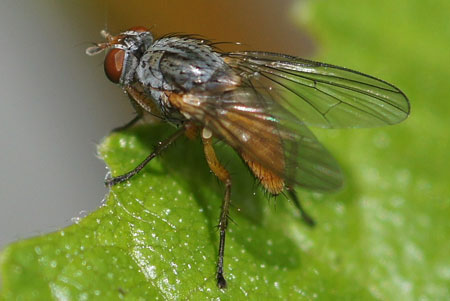
Root-Maggot Fly spec.
Family Root-Maggot Flies (Anthomyiidae)
Greek: anthos = flower en myia = fly |
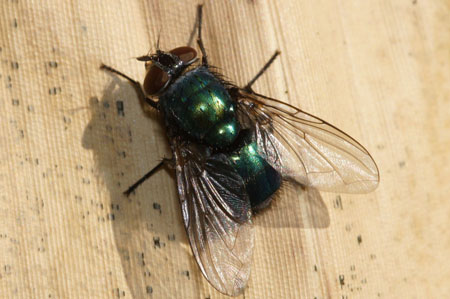
Greenbottle, Lucilia spec Maybe (Lucilia
caesar)
Family Blow-fl
(Calliphoridae)
|
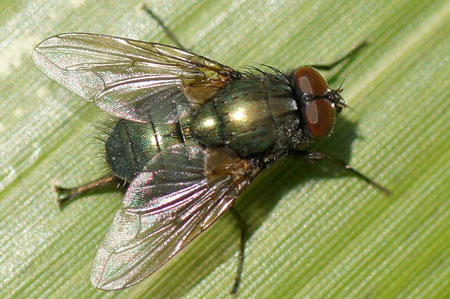
Eudasyphora
cyanella
Family House
flies (Muscidae) |
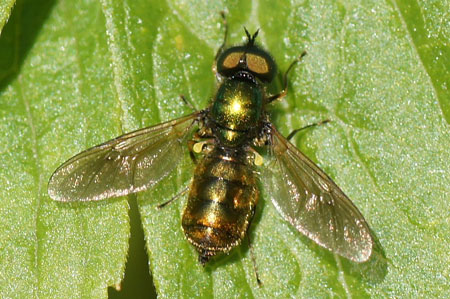
Broad Centurion, Green Soldier Fly (Chloromyia
formosa)
Family: Soldierflies (Stratiomyidae)
|

Tachina
fera / Tachina magnicornis
Family: Tachinidae Larvae of Tachina species parasites on larvae of other insects.
|
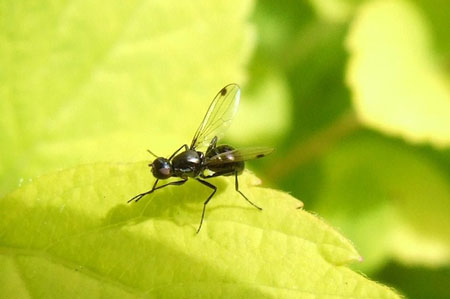
Black scavenger flies or ensign flies (Sepsidae)
All families, mainly of very small flies are available on a separate page.
|
| Other families of flies. They are arranged alphabetically.
I have used the scientific (Latin) name.
|
Roberflies (Asilidae).
Robberflies(Asilidae)
are
flies, which catch other flies in the same way as dragonflies with
their forelegs. The
short, strong proboscis is used to stab and inject victims with saliva
containing neurotoxic and proteolytic enzymes. The fly then sucks the
liquefied meal through the proboscis.
All
robber flies have stout, spiny legs.
They aid in pray capture.
Larvae live in the soil and decaying wood. They also feed on other insects.
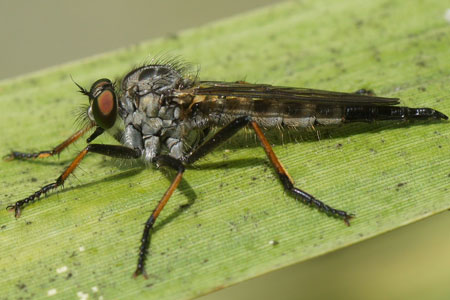 .. ..  female
female  male Common
Awl Robberfly (Neoitamus
cyanurus). Subfamily Asilinae. Family Robber
flies (Asilidae). male Common
Awl Robberfly (Neoitamus
cyanurus). Subfamily Asilinae. Family Robber
flies (Asilidae).
This is most common species.
It often occurs in the neighbourhood of oaks. It is already bee found
early in spring.
May - September.
Length: 20 - 25 mm. Photos 8-6-2012, 5-6-2012. |
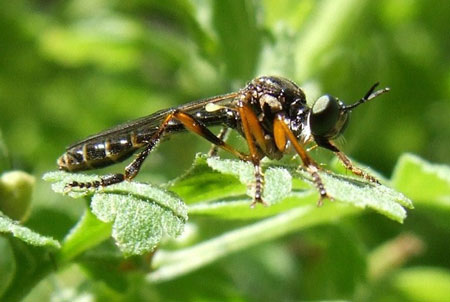 .. ..
 . .
 Dioctria hyalipennis.
Subfamily Dioctriinae.
Family Robber
flies (Asilidae). Dioctria hyalipennis.
Subfamily Dioctriinae.
Family Robber
flies (Asilidae).
A Small robberfly. forests and shrubs Characterization: The middle of and forefeet are red, a continuous silver line on the
side of the brisket. Length 12 -14 mm.
Other resembling species: Dioctria
rufipes, Dioctria
linearis. |
Robber flies photographed in the dunes about 4 km from our house.
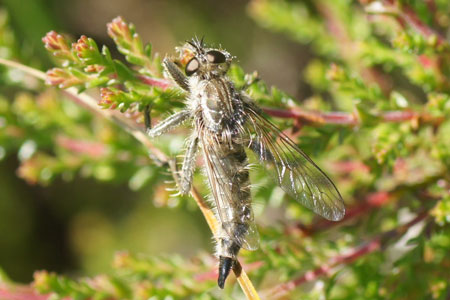 .. ..
 Dysmachus trigonus. Subfamily
Asilinae.
Family Robber
flies (Asilidae).
Female.
Dysmachus trigonus. Subfamily
Asilinae.
Family Robber
flies (Asilidae).
Female.
Sandy soils. Lots of light brushes on the segments of the abdomen dark triangles. The ovipositor of the female is on the side flattened. April
- August. Length 10 -15 mm. Photo 30-6-2013. |
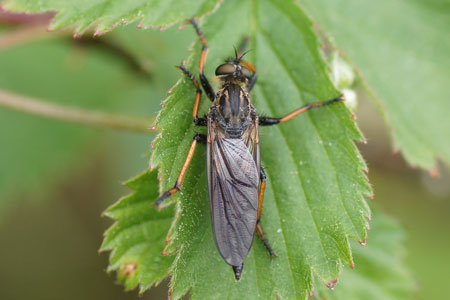 Pamponerus germanicus. Subfamily
Asilinae.
Family Robber
flies (Asilidae). Pamponerus germanicus. Subfamily
Asilinae.
Family Robber
flies (Asilidae).
A large robber fly. Edges of woods, dunes. Red-brown with dark legs thighs. May - July. Length 17 -21 mm. Photo 26-6-2013. |
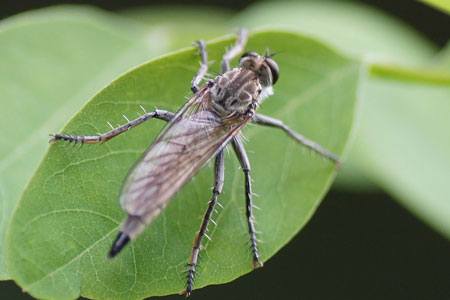 Philonicus albiceps. Subfamily
Asilinae.
Family Robber
flies (Asilidae). Philonicus albiceps. Subfamily
Asilinae.
Family Robber
flies (Asilidae).
Sandy soils, heath, poor grasslands. Ovipositor female is round. Black legs with mostly white
bristles and short grey hairs. May - October. Length 12 -20 mm. Photos 24-6-2014. |
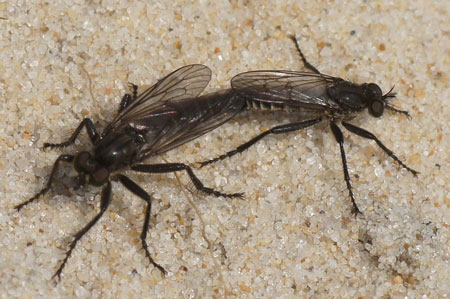 .. ..
 Lasiopogon cinctus. Subfamily
Stichopogoninae. Family Robber
flies (Asilidae). Lasiopogon cinctus. Subfamily
Stichopogoninae. Family Robber
flies (Asilidae).
A small robber fly. Forest edges, sandy soils. Black legs.
April - September. Length 7 -11 mm. Photos 3-5-2013, 11-6-2013. |
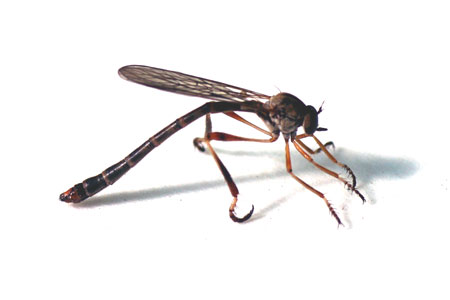 male
male 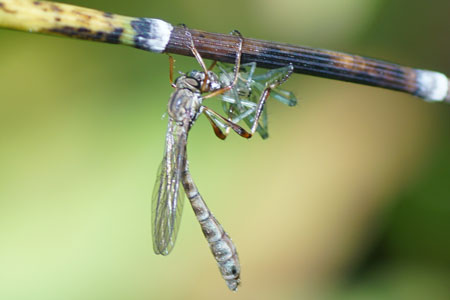 female Leptogaster guttiventris. Subfamily
Leptogastrinae. Family Robber
flies (Asilidae).
Rare
in the Netherlands!!
female Leptogaster guttiventris. Subfamily
Leptogastrinae. Family Robber
flies (Asilidae).
Rare
in the Netherlands!!
Very slender robber fly with thin, long abdomen. The first is a male photographed in the greenhouse. The second a female with a spider as prey in the garden.
There are three similar species, Leptogaster cylindrica and the rare Leptogaster guttiventris and Leptogaster subtilis. At first I thought it was Leptogaster cylindrica, but it turned out to be Leptogaster guttiventris.
Difference with Leptogaster cylindrica. No dark longitudinal stripe on the abdomen, thigh 3 has a dark ring on the top half instead of a spot or stripe and the shin 3 is usually not black. Similar to Leptogaster subtilis, but it has a yellow instead of a black snout and is even rarer in the Netherlands.
May-October. Length 8-13mm. Photos 21-6-2023, 23-7-2023. Elias de Bree thanks for the identification. |
Bee flies (Bombyliidae)
Bee Flies have pubescent (hairy) bodies like bumble bees.
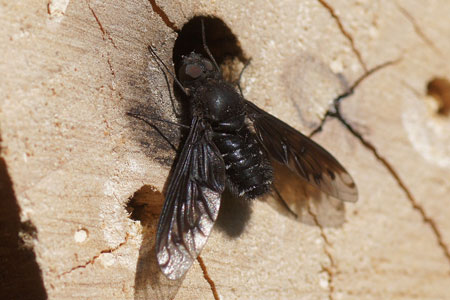 .. ..
 Anthrax anthrax. Genus Anthrax. Familiy Bee flies
(Bombyliidae). Anthrax anthrax. Genus Anthrax. Familiy Bee flies
(Bombyliidae).
It's a black fly. The wings are black. Only the edges of the wings are partially transparent. On the black abdomen are white hairs.
The larvae live in nests of mason bees. At the entrance of the nest the female lays the eggs. The larvae eat the pollen and nectar supply. The eggs and larvae of the bees are
also eaten by the larvae of the Anthrax anthrax.
Length: 7 - 13 mm.
Photos 17-6-2012 en 2-7-2012. |
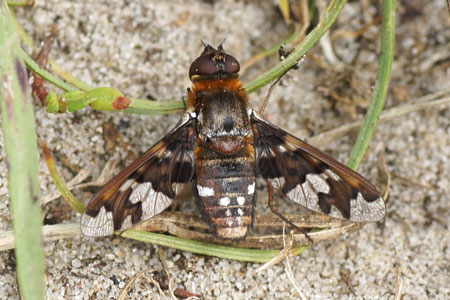 Exoprosopa capucina.
Familiy Bee flies (Bombyliidae). Not in the garden but
in de dunes about 4 km vfrom our house. Exoprosopa capucina.
Familiy Bee flies (Bombyliidae). Not in the garden but
in de dunes about 4 km vfrom our house.
It has striking dark brown wings with clear spots. The body is gray-brown, and behind the head is a collar of red hairs. On the abdomen are white spots.
The larva seems a parasite of the larvae of digger wasps on caterpillars.
In the Netherlands they occur in the sandy heathland and the dunes .
Length: 9-14 mm. Europe, Near East.
Photo 24-6-2015. |
Thick-headed flies, Conopid flies (Conopidae)
Thick-headed flies have long antennae, a long snout and a curved body.
Thick-headed flies because of the thick (inflated) head
Conopid flies deposit eggs on the abdomen especially of wasps, bees and bumblebees. This happens in flight. The larvae are
internal parasites or endoparasites. The larvae develops inside the abdomen.
The development is completed within 10 - 12 days, when the host is killed.
To determine the
Conopid flies you can use "de veldtabel van John Smit" blaaskopvliegen van Nederland en België.
The explanation is in Dutch with many photos. Only about the
Conopid flies in the Netherlands anh Belgium.
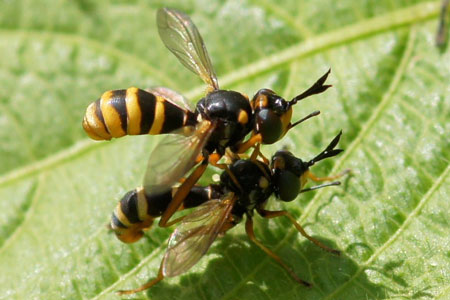 .. ..
 .. ..
 .. ..
 Conops
quadrifasciatus. Family Thick-headed flies,
Conopid flies (Conopidae). Conops
quadrifasciatus. Family Thick-headed flies,
Conopid flies (Conopidae).
There are some similar species. Conops
quadrifasciatus has orange, yellow legs.
Their larvae are endoparasites of bumble bees of the genus Bombus. Length: 9 - 16 mm.
Photos: 16-08-2009. Photos couple: 16-08-2011.
The same day, not the same year. German: Vierstreifige
Dickkopffliege. |
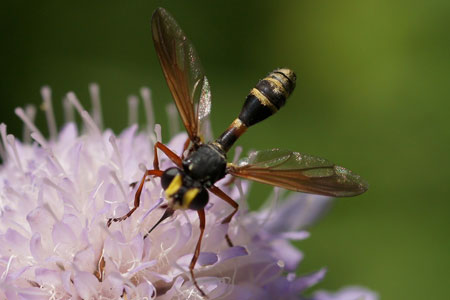 .. ..
 . .
 . .
 Physocephala rufipes. Family
Thick-headed flies.
Conopid flies (Conopidae). Physocephala rufipes. Family
Thick-headed flies.
Conopid flies (Conopidae).
Physocephala rufipes has a small, long second
segment. The other segments are broader and shorter.
Under the antennae is a black stripe. Other species in the Nettherlands are:
Physocephala nigra (rare), Physocephala chrysorhhoea, Physocephala vittata.
The larvae are endoparasites of Sphecidae, bees,
bumble bees and social wasps. Length: 9 - 13 mm. |
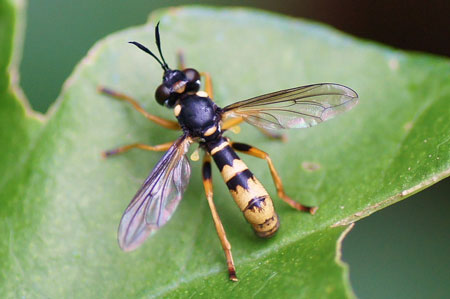 Leopoldius.
Family
Thick-headed flies,
Conopid flies (Conopidae).
Leopoldius.
Family
Thick-headed flies,
Conopid flies (Conopidae).
There are four species in the Netherlands. Namely Leopoldius
brevirostris, Leopoldius coronatus, Leopoldius signatus and Leopoldius
valvatus. They are all rare.
At the moment I took this picture, it was gloomy weather. After the photo the fly was disappeared. To be able to identify
this fly I needed a photo of the front.
Photo 20-9-2011. |
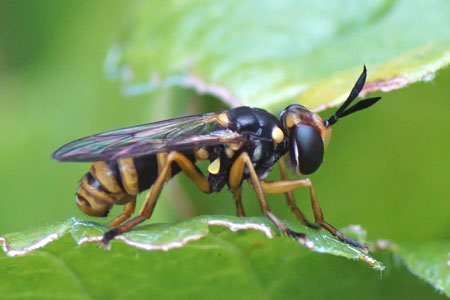 .. ..
 Leopoldius brevirostris. Family
Thick-headed flies,
Conopid flies (Conopidae). Female
Leopoldius brevirostris. Family
Thick-headed flies,
Conopid flies (Conopidae). Female
Twelve years after photographing the Leopoldius in 2011 I saw another one in the garden. Bad weather again. Fortunately, I was now able to photograph it from several sides before it flew away. And Elias de Bree was able to identify it to the species.
Photos 21-7-2023. |
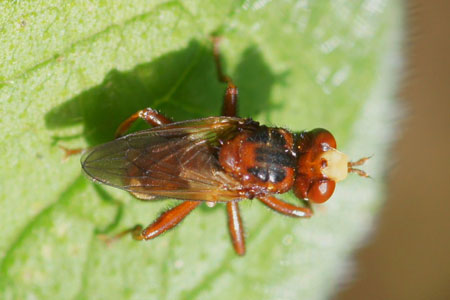 .. ..
 . .
 . .
 Sicus ferrugineus. Family Thick-headed flies,
Conopid flies (Conopidae).
Sicus ferrugineus. Family Thick-headed flies,
Conopid flies (Conopidae).
A reddish brown Conopid fly.
The larvae are endoparasites of bumblebeesof the genus Bombus. May - September.
Europe.
Photos 27-6-2010, 9-7-2013. German: Gemeine
Breitstirnblasenkopfliege. |
The different species Myopa are very similar. Striking is the large, white face (below the eyes).
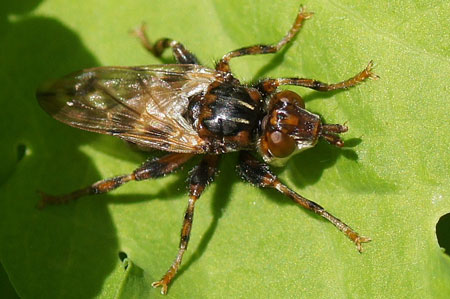 .. ..
 . .
 Myopa
buccata. Family Thick-headed flies,
Conopid flies (Conopidae). Myopa
buccata. Family Thick-headed flies,
Conopid flies (Conopidae).
A very colourful brown black beak with a striking white head. The wings have an extensive spots pattern, where there is always a white spot on cross vein R-M. All thighs with a black ring on the middle.
On these photos they are sitting in a currant bush, which is often visited by the hosts of their
larvae (bees, wasps, bumblebees). Photos 12-4-2012, 14-4-2012. |
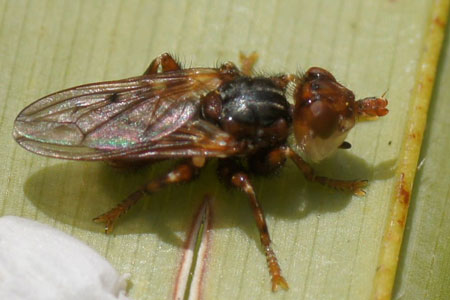 .. ..
 Myopa
testacea. Family Thick-headed flies,
Conopid flies (Conopidae). Myopa
testacea. Family Thick-headed flies,
Conopid flies (Conopidae).
A dark brown Myopa with just a clear spot in the wing cross vein RM. Sometimes there is to distinguish vague darkening in the top of the wing, but these are never clear spots. Thorax to the scutellum completely black. Because of the spot on the wing it is not to be confused with other
Myopas. Length 6 - 11 mm. April - July. Text taken from "Waarneming"
(translated). John Smit thanks for identify. Photos 30-4-2013.
|
Long-legged flies (Dolichopodidae)
The
flies are
slender with
long slender
legs.
The colour
varies,
but they
usually have a
shiny metallic
color.
The size of flies in this family is from 1 mm to 9 mm. The arista is upright on the end of the antenna.
Both the fly and larvae are mainly predators. (invertebrates, larvae)
Especially in a humid environment.
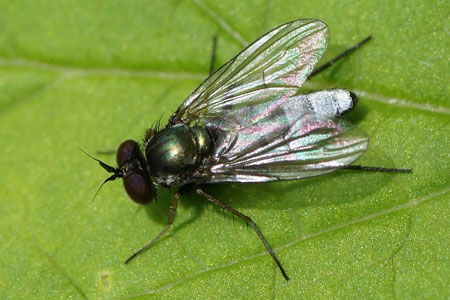 .. ..
 . .
 Argyra diaphana. Family long-legged flies (Dolichopodidae). Argyra diaphana. Family long-legged flies (Dolichopodidae).
Very light abdomen. The thorax is shiny green. There are some similar species.
Thanks Marc Pollet for the identification. Photos 26-6-2013. |
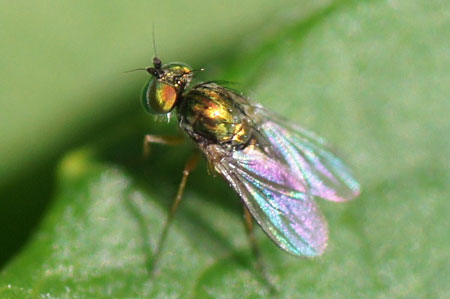 .. ..
 Chrysotus neglectus.
male. Family long-legged flies
(Dolichopodidae). Chrysotus neglectus.
male. Family long-legged flies
(Dolichopodidae).
Very small shiny golden flies. In the Netherlands 16 species. The name of the species
was first not possible. But... expert Marc Pollet identified it as Chrysotus neglectus. Photos 4-6-2012. |
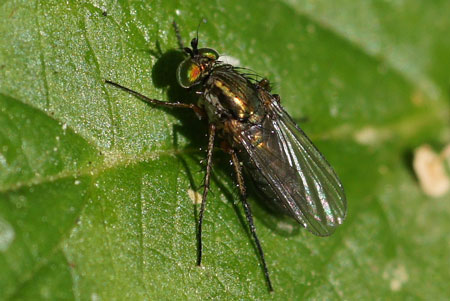 .. ..
 Dolichopus spec. Family long-legged flies
(Dolichopodidae.
Dolichopus spec. Family long-legged flies
(Dolichopodidae.
I don't know the species. The fly is beautifully shiny metallic green. The eyes are shiny too. The legs are long and slender.
Photos 14-5-2011 en 24-4-2011. |
 .. ..
 Dolichopus ungulatus. Family long-legged flies
(Dolichopodidae). Dolichopus ungulatus. Family long-legged flies
(Dolichopodidae).
A larger species,
which I
found
on the
window frame
in the pantry.
Metallic green
with light
legs. |
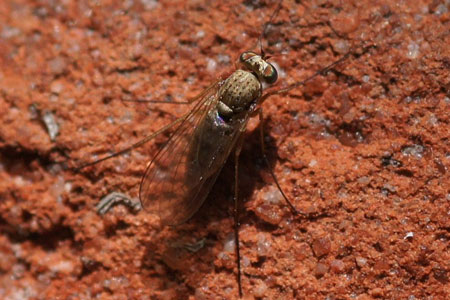 .. ..
 Sciapus. Family
long-legged flies (Dolichopodidae). Sciapus. Family
long-legged flies (Dolichopodidae).
John Carr: A species of Sciapus, the only genus of Dolichopodidae in your area with forked M
vein.
Niels-Jan: Probably
it
will be
Sciapus platypterus,
but a female
is not possible from
a
photograph.
Males have white
on the middle
tarsi.
Photos 2-6-2011. Small,
on
the wall. |
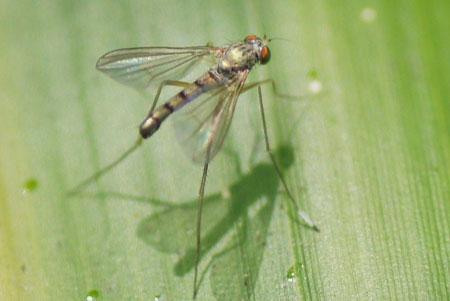 .. ..
 Sciapus
platypterus. Family long-legged flies (Dolichopodidae). Sciapus
platypterus. Family long-legged flies (Dolichopodidae).
A slim fly easily recognizable by the white tarsi of the middle leg. In my garden it usually
walks on its long legs in the shade. Photos 12-6-2012. |
 .. ..
 Neurigona
quadrifasciata. Family long-legged flies (Dolichopodidae). Neurigona
quadrifasciata. Family long-legged flies (Dolichopodidae).
A slender fly with long legs. The abdomen is yellow with dark spots at the top.
Often on tree trunks. Europe. Length 3.5 -
5 mm.
Photos 29-5-2013, |
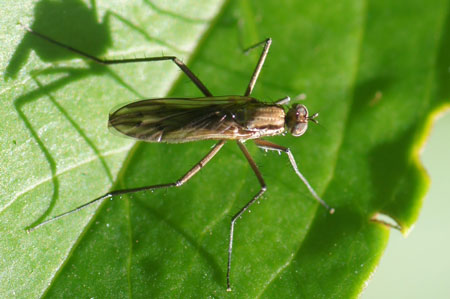 .. ..
 Scellus
notatus. Family long-legged flies (Dolichopodidae).
Photos 5-7-2017. Scellus
notatus. Family long-legged flies (Dolichopodidae).
Photos 5-7-2017. |
 Xanthochlorus galbanus. male. Family long-legged
flies (Dolichopodidae).
Xanthochlorus galbanus. male. Family long-legged
flies (Dolichopodidae).
Very small. In the Netherlands four similar species (Xanthochlorus galbanus,
Xanthochlorus silaceus, Xanthochlorus tenellus, Xanthochlorus ornatus)
Ik thought Xanthochlorus tenellus or maybe Xanthochlorus ornatus.
Xanthochlorus tenellus is completely yellow with sometimes a dark, greenish
part on the thorax. 2.5-3.5 mm. Xanthochlorus ornatus is also yellow, but
with a darkened, greenish, bronze or greyish thorax and scutellum. 2.75-3.0
mm. But... expert Marc Pollet identified it as Xanthochlorus galbanus
in November 2021. Thanks Marc. Photo 12-7-2018.
Here much more information: The British species of Xanthochlorus
Loew, 1857 (Diptera, Dolichopodidae), with description of two new species |
Dance Flies, Balloon Flies, Dagger Flies or Empids (Empididae)
Dance flies are predatory flies. On the photo you can see the long snout. Dance fly, because the males dance for the females. They also offer the
females a prey. There are many small species.
I've photos of the genus Empis, Rhamphomyia en Hilara. Differences
are: The fork in the wing veins in the wing tip of wing of the Hilara is
long. In the wing of the Empis it is short-triangular and it lacks in the
wing of the Rhamphomyia.
They don't stabbing people.
 .. ..
 . .
 Empis tessellata. Family Empididae. Empis tessellata. Family Empididae.
You can see them also on flowers. The lower part of the legs is red brown. The beginning of the wings is orange brown. Length 9 - 11 mm.
May - August. Europe, North Africa, Asia. Photos 22-5-2013. German: Gewürfelte
Tanzfliege. |
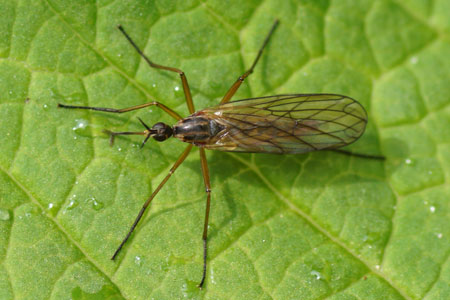 Empis trigramma. Family Empididae.
Empis trigramma. Family Empididae.
Thorax with three broad dark stripes. Yellowish sides. Golden yellow abdomen with a dark center stripe. Length 4.5-6mm. April-June.
Photo 14-5-2023.
|
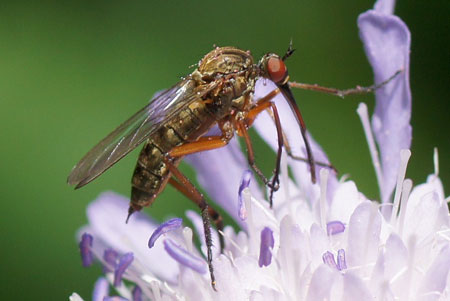 .. ..
 Empis
livida. Family Empididae. Empis
livida. Family Empididae.
A male. The legs are brown. Length 7 - 10 mm.
April - July.
Photo 19-6-2011, 26-6-2012. |
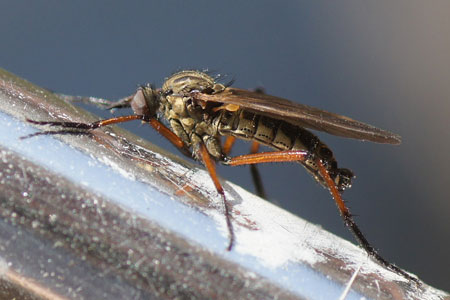 .. ..
 Empis opaca.
Family Empididae. Empis opaca.
Family Empididae.
A gray-black fly with orange legs and shiny black
"saddle" spots on the abdomen segments.
Length 6,5 - 9 mm. Photos 8-5-2013. |
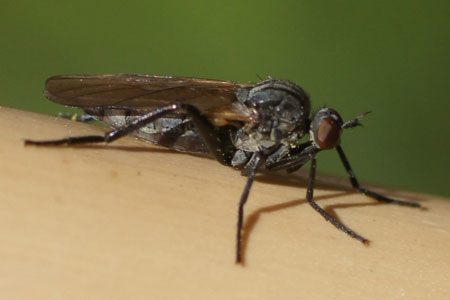 .. ..
 Rhamphomyia
spec. Family Empididae. Photos 4-5-2013. Rhamphomyia
spec. Family Empididae. Photos 4-5-2013. |
Fanniidae
Family: Small flies.
Mostly grey - black. The larvae live in decaying organic matter.
 Larva Fannia, photo 16-2-2018.
Larva Fannia, photo 16-2-2018.
|
 . .
 |
Fannia spec. Family Fanniidae.
There were several of these flies as well males as females. Length about 4
mm, shiny black. There are many similar flies of the family Faniidae. It isn't possible
to determine these flies from a photo. Photos 24-5-2013. |
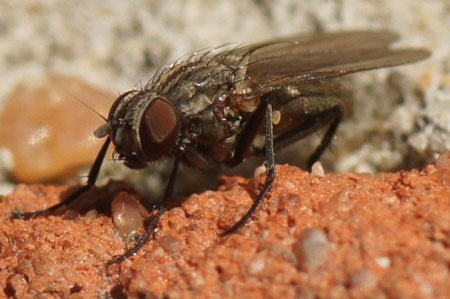 .. ..
 . .  Lesser housefly
(Fannia canicularis).
Family Fanniidae. Photos 12-11-2012. Length 4 - 6 mm. Lesser housefly
(Fannia canicularis).
Family Fanniidae. Photos 12-11-2012. Length 4 - 6 mm. |
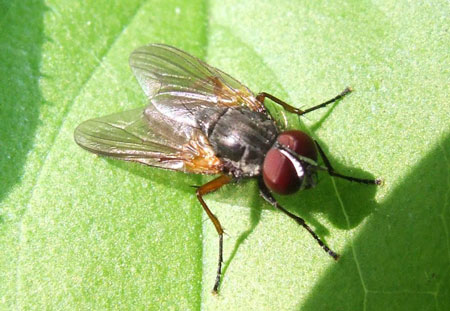 . .
 . .
 Fannia lustrator.
Family Fanniidae.
Photos 17-4-2009. Characteristic to the Fannia lustrator are the
orange legs. Photo 1 and 2 male. Photo 3 female. Photos 17-4-2009, 13-5-2022.
Fannia lustrator.
Family Fanniidae.
Photos 17-4-2009. Characteristic to the Fannia lustrator are the
orange legs. Photo 1 and 2 male. Photo 3 female. Photos 17-4-2009, 13-5-2022. |
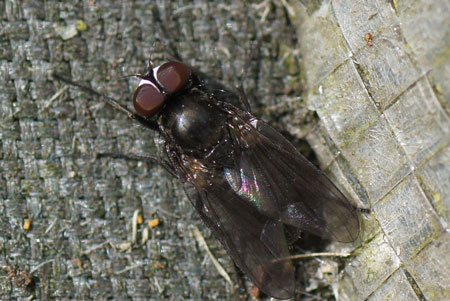 .. ..
 . .  Fannia
manicata.
Family Fanniidae. Fannia
manicata.
Family Fanniidae.
The tuft of hairs on the underside of the front shin is an important characteristic of the Fannia
manicata. Photos 20-4-2012. |
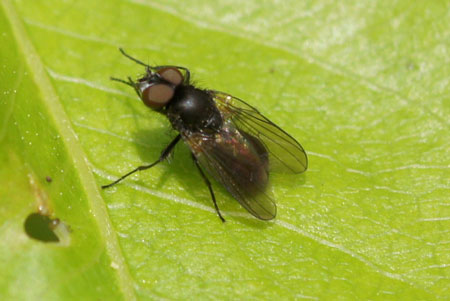 .. ..
 Fannia
mollissima.
Family Fanniidae.
Photos 6-5-2010. A small, dark fly. About 5 mm. Fannia
mollissima.
Family Fanniidae.
Photos 6-5-2010. A small, dark fly. About 5 mm. |
Heleomyzidae
The larvae often live in decaying organic material, fungi (genus
Suillia).
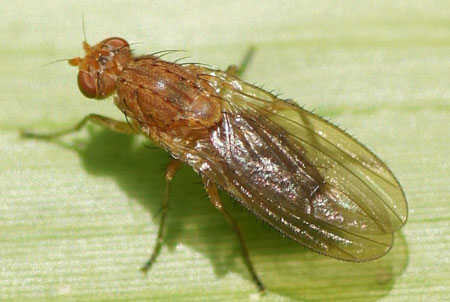 .. ..  Suillia spec. Family
Heleomyzidae. Suillia spec. Family
Heleomyzidae.
Notable are the
‘spines’ on the wing edge.
Suillia species are oft in the neighbourhood of mushrooms. Therefore you
can find them mainly in autumn.
Photos 25-10-2012. |
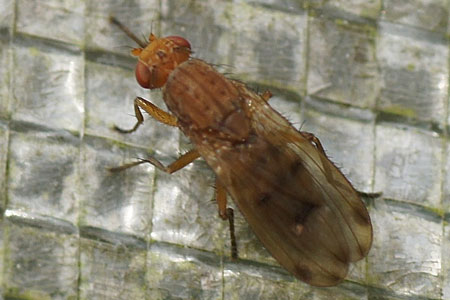 .. ..
 Suillia spec. Family
Heleomyzidae. Suillia spec. Family
Heleomyzidae.
Suillia similis has on the wings three dark spots and darkened cross veins.
But there are more species with these marks like Suillia flava and Suillia
ustulata. Photos 29-9-2014. |
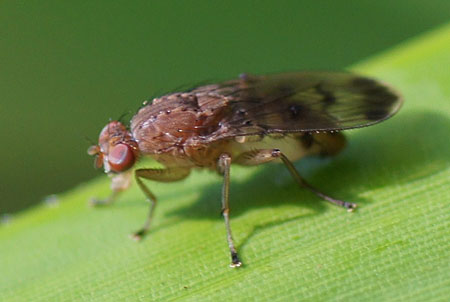 .. ..
 . .  Suillia variegata. Family
Heleomyzidae. Suillia variegata. Family
Heleomyzidae.
Suillia affinis resembles this fly.
The wings of Suillia variegata have darker patches. There's a small pale area on the tip after a darker patch.
Photos 17-10-2011. |
 Tephrochlamys rufiventris.
Family Heleomyzidae.
Tephrochlamys rufiventris.
Family Heleomyzidae.
The larva can be found in waste, manure hope. That's why you find the fly
oft in the neighbourhood of farms. There are even a few species of this
family in the pool area.
I have photographed this species December 25. This
fly must be able to handle the cold. There are flies similar to
Tephrochlamys rufiventris. But they are not so late or early in the year. Photo 25-12-2008. |
Megamerinidae
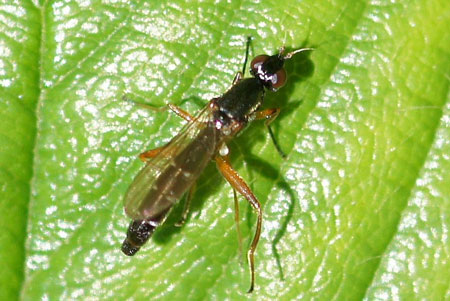 .. ..
 Megamerina dolium. Family
Megamerinidae. Megamerina dolium. Family
Megamerinidae.
Megamerina dolium is
Europe's only
species of
the family. They
are slim,
dark and shiny.
The legs are
orange. I
thought at first
that it
was a
wasp when
I saw it in the garden.
Size 6
- 9 mm.
The larvae are
predators. They
live under the
bark of
dead trees.
Photos 16-8-2011, 2-7-2014. |
Big-Headed Flies
There
are both small and large
flies in
this family. 3.5-11.5mm.
Usually
they
are hairless
dark flies
with very large eyes.
The larvae are
parasites of cicadas.
The cicadas don't
survive,
because it
is finally completely
eaten.
Then the
larvae pupate
in the soil.
They are related to
hover flies.
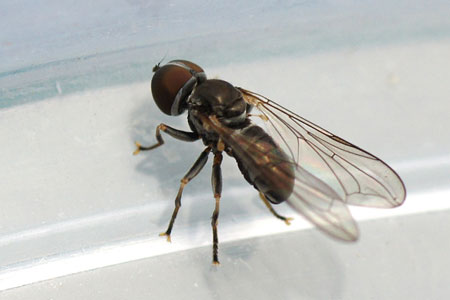 .. ..
 . .
 . .
 Big-Headed Fly. Family Big-Headed Flies (Pipunculidae). Big-Headed Fly. Family Big-Headed Flies (Pipunculidae).
The species can not be determined from these photos. It's a small fly with big eyes. About 4 - 5 mm. Photos 27-6-2015, 30-6-2015, 17-6-2011. |
Rust flies (Psilidae)
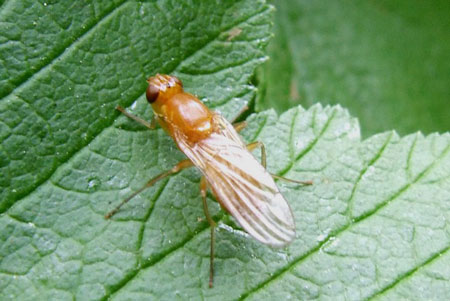 .. ..
 . .
 Carrot fly. Psila merdaria
or Psila fimetaria. The difference is not
visible on these photos. Family Rust flies (Psilidae). Carrot fly. Psila merdaria
or Psila fimetaria. The difference is not
visible on these photos. Family Rust flies (Psilidae).
A
striking orange fly. It has few brushes
and clear wings. The length of this fly was about one cm. The larvae of the carrot flies are fytofaag
(plant eating). They live in the roots, bulbs and non-woody stems. Photos 24-5-2009. |
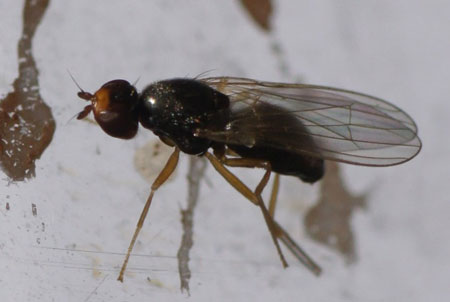 .. ..
 Chamaepsila spec. Family Rust flies
(Psilidae). Chamaepsila spec. Family Rust flies
(Psilidae).
A shiny dark fly with an orange front of the head. The legs are yellow-orange. Well known is the carrot fly Chamaepsila
rosae, whose larvae damage in carrots, but
also celery, parsley, leeks, onions. However in the Netherlands there are more
similar Chamaepsila species. Length about 4 - 5 mm.
Photos 5-5-2014. |
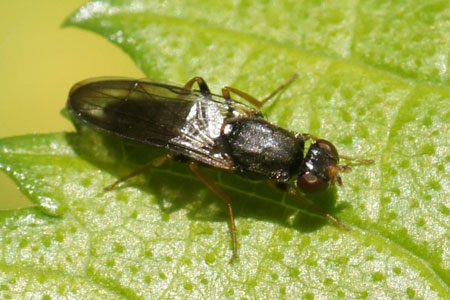 .. ..
 Chyliza annulipes. Family Rust flies
(Psilidae).
Chyliza annulipes. Family Rust flies
(Psilidae).
A black fly withe orange legs, antennae and front of the head. The wings are dark at the end. the and of the scutellum is brown. Femora very obviously ringed with black before the tip. About 7 mm. Photo 30-4-2017. |
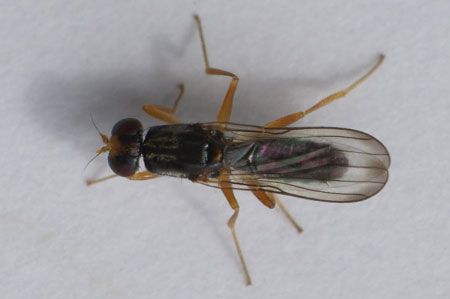 .. ..
 . .
 Chyliza leptogaster. Family Rust flies
(Psilidae).
Chyliza leptogaster. Family Rust flies
(Psilidae).
A black fly withe orange legs, antennae and front of the head. The wings are dark at the end. the and of the scutellum is brown. About 7 mm. Photos 21-6-2016. |
Snipe flies (Rhagionidae)
Snipe flies are small- or large-sized flies.
They have slender bodies, long legs and long wings.
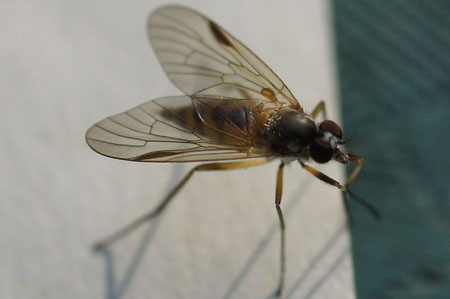 .. ..
 . .
 Small Fleck-winged Snipe Fly, Rhagio lineola. Family snipe flies
(Rhagionidae). Small Fleck-winged Snipe Fly, Rhagio lineola. Family snipe flies
(Rhagionidae).
About 8 mm. Photos 10-7-2010,
17-7-2014. |
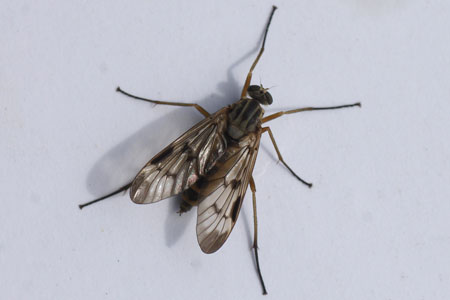 .. ..
 Downlooker snipefly ( Rhagio scolopaceus). Family snipe flies
(Rhagionidae). Female and male. Downlooker snipefly ( Rhagio scolopaceus). Family snipe flies
(Rhagionidae). Female and male. |
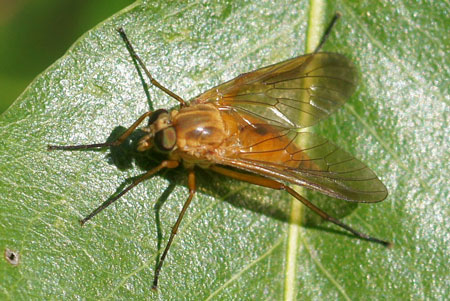 .. ..
 Rhagio tringarius.
Family snipe flies (Rhagionidae). Female.
Rhagio tringarius.
Family snipe flies (Rhagionidae). Female.
A
yellow-brown
fly.
The thorax is
slightly darker
yellow with
brown stripes
in length.
On
the abdomen are
dark spots.
The male is
slimmer, the
tip of the
abdomen of
the male is
dark.
The larvae feed
on larvae of other species and
live
in the damp
soil. The
adult fly
seems to
catch other
flies.
Length
8 to 14 mm.
|
 .. ..
 Female.
Female.  Male. Chrysopilus cristatus. Family snipe flies (Rhagionidae).
Male. Chrysopilus cristatus. Family snipe flies (Rhagionidae).
Female: The abdomen is golden coloured. On the thorax you see two grey dusted stripes.
Male (left): It is slimmer and darker with unclear or no stripes. It looks like the in the Netherlands much rarer C.
splendidus.
Length 6-8 mm. Europe. Photos 6-6-2011, 2-7-2012. |
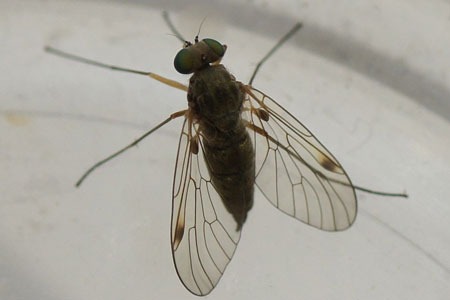 .. ..
 Female.
Female.  Male.
Chrysopilus asiliformis. Family snipe flies (Rhagionidae). Male.
Chrysopilus asiliformis. Family snipe flies (Rhagionidae).
Head, thorax and abdomen are grey dusted. Green eyes. Brownish-yellow thighs. Length 6-9 mm. Photos 26-6-2014, 26-6-2016. |
Rhinophoridae.
It also has the stiff
hairs like the Tachinidae. The antennae are smaller.
In the Netherlands there are 7 species. The larvae are parasitoids of woodlice.
Parasitoids like the larvae of the Tachinidae. More
information
about Rhinophoridae.
In the Netherlands the family
Rhinophoridae consists of six genera. The genus Stevenia consists of two
species. The other genera consist of one species.
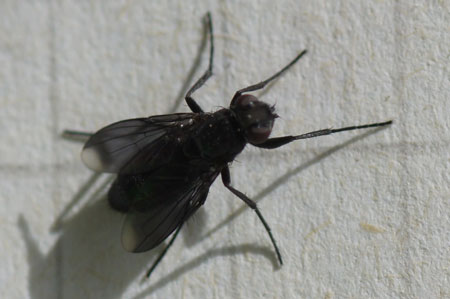 .. ..
 . .
 Melanophora
roralis. Family Rhinophoridae. Melanophora
roralis. Family Rhinophoridae.
It has dark wings with clear veins. The females have white wing tips.
About 5 mm. Photo 17-6-2011, 17-6-2013, 15-5-2014. |
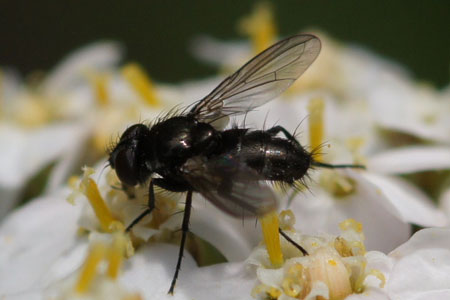 .. ..
 Rhinophora lepida. Family
Rhinophoridae. Rhinophora lepida. Family
Rhinophoridae.
A small, shiny dark fly. I see these flies in June and
July on many flowers in the garden. In the first two pictures it is on Yarrow.
Photos 12-6-2011. |
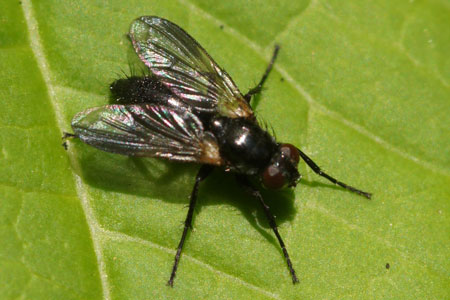 .. ..
 Paykullia maculata. Family Rhinophoridae. Paykullia maculata. Family Rhinophoridae.
A shiny black fly.
The wings are partly dark.
Photos 7-10-2013. |
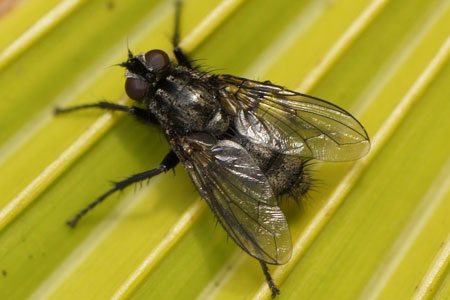 .. ..
 Phyto melanocephala. Family Rhinophoridae.
Photos 24-11-2011. Very, very late for this fly. Phyto melanocephala. Family Rhinophoridae.
Photos 24-11-2011. Very, very late for this fly. |
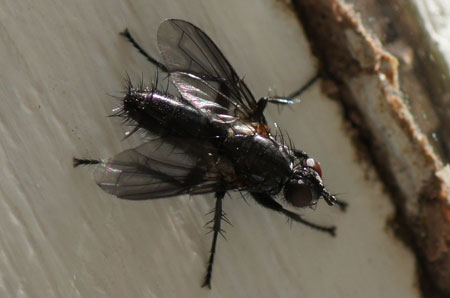 .. ..
 Stevenia umbratica. Family Rhinophoridae.
Probably for it is very similar to Stevenia atramentaria.
Photos 22-7-2012. Stevenia umbratica. Family Rhinophoridae.
Probably for it is very similar to Stevenia atramentaria.
Photos 22-7-2012. |
Dung-flies, Scathophagidae
The
size varies.
3 to 12 mm.
The body and legs often have many brushes and hairs. The
larvae live in
rotting organic
wastes such as manure.
But there are also
larvae, which are miners.
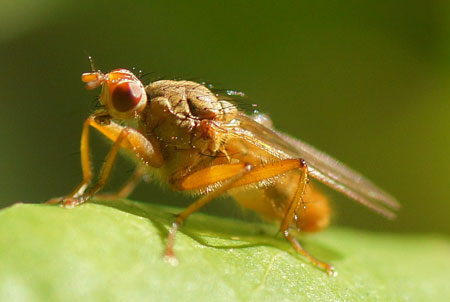 .. ..
 . .
 Other
Scathophaga Other
Scathophaga  Scathophaga spec.
Family Dungflies (Scathophagidae). Scathophaga spec.
Family Dungflies (Scathophagidae).
Scathophaga with light coloured antennae are
difficult to determine.
The Scathophaga furcata have a light coloured antenna, but
species like Scathophaga lutaria and for example S. Suilla. have
also light antennae.
They catch other flies... often on
mammal faeces.
Photos 16-10-2011 |
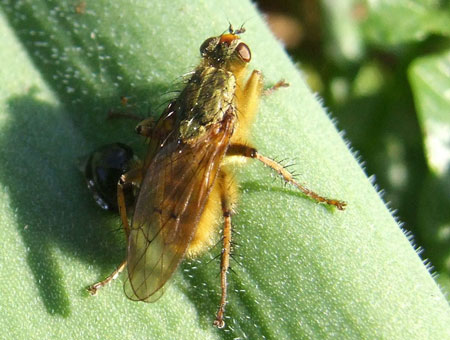 .. ..  . .
 . .
 . .
 Dungfly (Scathophaga stercoraria). Family
Dungflies (Scathophagidae).
Dungfly (Scathophaga stercoraria). Family
Dungflies (Scathophagidae).
Scathophaga stercoraria can be recognized by the dark antennae. A very
common species. In the Netherlands only the antennae of the much rarer Scathophaga litorea
are dark too. Outside the Netherlands lives the Scathophaga calida. (Both species occur on the coast).
They catch other flies, but sometimes
they feed on nectar.
The females are less hairy and they're grayer.
Photos April
2009. German:
Gelbe Dungfliege, Gemeine Kotfliege French: scatophage du fumier, mouche
à merde. |
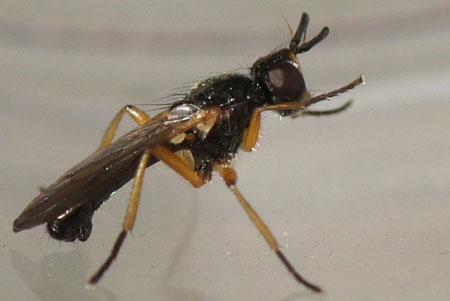 .. ..
 . .
 Micropselapha
filiformis
Family
Dungflies Scathophaga. Micropselapha
filiformis
Family
Dungflies Scathophaga.
A slender black fly with yellow red legs without spines of many family members and with a dark tarsus. The black antennae are long and have a yellowish
arista.
It isn't often seen in the Netherlands. About the way of life is not much known to me.
Photos 27-4-2015. |
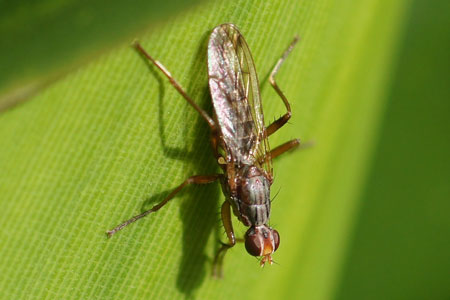 Daffodil fly (Norellia spinipes). Family Dungflies Scathophaga. Daffodil fly (Norellia spinipes). Family Dungflies Scathophaga.
The spines on the thigh are characteristic. (spinipes: thorny legged)
The female put the eggs on the leaves of the daffodil. (down near the bottom) The larva eats mainly in the part under the soil (leafminer). Therefore the outer leaves die off. The bulbs have no damage. They are often less large. Photo: 4-4-2011. |
Sarcophagidae
Small
to very
large flies.
3 -22
mm.
Characteristics: Stripes on the thorax, red eyes and
a checkerboard like pattern on the abdomen. Because
of their brushes
they
look like tachinidae. The larvae are parasites. Furthermore, I 've
found different descriptions in books and sites. There are written about
food sources such as earthworms, insect larvae, pupae, but also dead
animals.
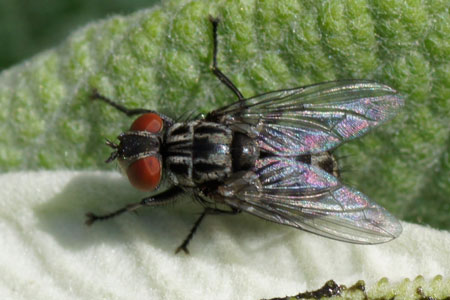 .. ..
 . .
 Macronychia spec.
Subfamily Miltogramminae. Family Sarcophagidae.
Macronychia spec.
Subfamily Miltogramminae. Family Sarcophagidae.
The species in The Netherlands are Macronychia agrestis, Macronychia
griseola, Macronychia polyodon,
Macronychia striginervis. Photos 15-6-2015. |
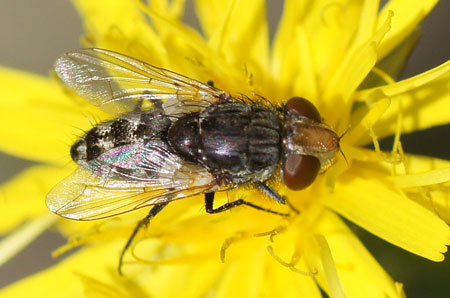 .. ..
 Miltogramma germari. Genus
Metopia. Subfamily Miltogramminae. Family Sarcophagidae.
Not in the garden but in the dunes 3 km from my house. Miltogramma germari. Genus
Metopia. Subfamily Miltogramminae. Family Sarcophagidae.
Not in the garden but in the dunes 3 km from my house.
The other two species in the Netherlands are M. punctata
and M. Testaceifrons. Miltogramma germari is recognizable by the light brown part on the head. The similarity with Metopia is clear. However, they have less hard bristles on the abdomen.
They are parasites of nesting wasps like Digger Wasps (Sphecidae).
Photos 12-7-2012. |
Sciomyzidae
It has got this name snail-killer
because the larvae
parasite on snails and slugs.
You can find all Dutch Sciomyzidae on
"Waarneming".
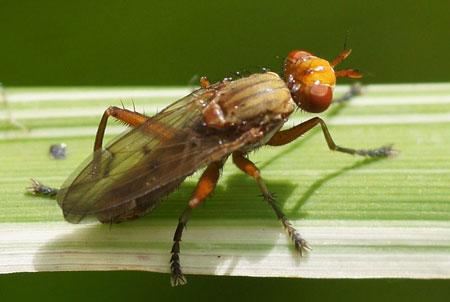 .. ..
 . .
 . .
 . .
 Marsh fly, snail-killer spec, Tetanocera spec. Family Sciomyzidae.
Marsh fly, snail-killer spec, Tetanocera spec. Family Sciomyzidae.
In the Netherlands there are many very similar species of this family. Tetanocera arrogans, T. elata, T. ferruginea, T. freyi, T. fuscinervis, T. hyalipennis, T. montana, T. phyllophora, T. punctifrons, T. robusta, T. silvatica.
They sometimes look similar on the flies of the family Scathophaga. But they are less hairy.Photos 4-7-2011, 25-4-2011, 23-4-2011, 24-4-2011, 27-9-2011. |
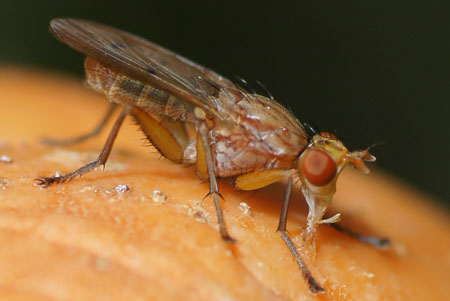 .. ..
 . .
 Tetanocera
ferruginea. Family
Sciomyzidae. Tetanocera
ferruginea. Family
Sciomyzidae.
Ths brown snail killer could be identified. On a rotten apple.
Foto's 5-10-2012. |
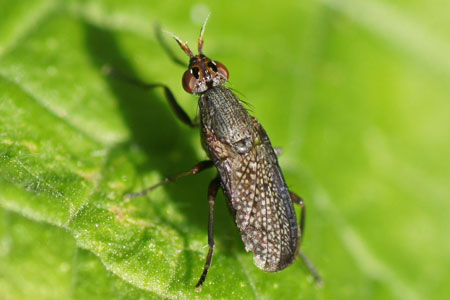 .. ..
 Coremacera
marginata. Family Sciomyzidae. Coremacera
marginata. Family Sciomyzidae.
A marsh fly with a greyish thorax and dark-greyish
wings with many light-greyish spots.
Length 7 - 10 mm. May - October. |
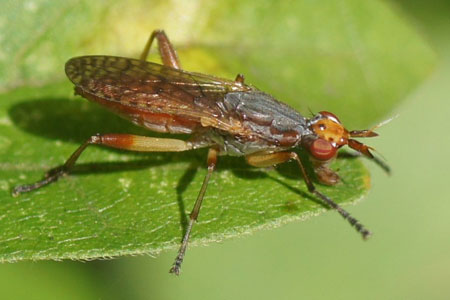 .. ..
 . .
 Dichetophora
obliterata.
Family Sciomyzidae. Dichetophora
obliterata.
Family Sciomyzidae.
The are yellow and red. The thorax
is grey, the wings with many
light-greyish spots. Length about 7
mm. Photos 27-8-2013. |
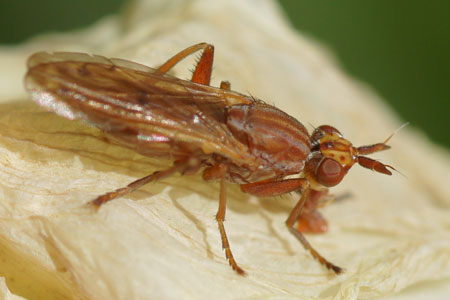 .. ..
 . .
 Elgiva solicita.
Family Sciomyzidae. Elgiva solicita.
Family Sciomyzidae.
It looks like the Tentanocera. In the
Netherlands, there are two species. The other species is Elgiva cucularia.
Photo 12-04-2011. |
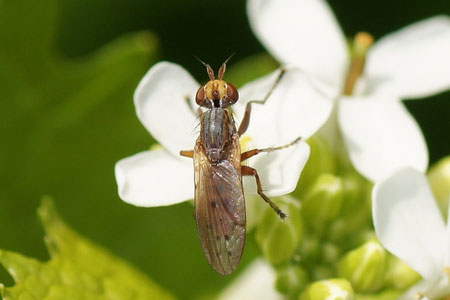 .. ..
 . .
 Hydromya dorsalis.
Family Sciomyzidae. Hydromya dorsalis.
Family Sciomyzidae.
Small and if you compare this fly with the other Sciomyzidae
the gray stripes on the back are striking . Photos 24-5-2013. On
the flowers of Garlic-mustard. |
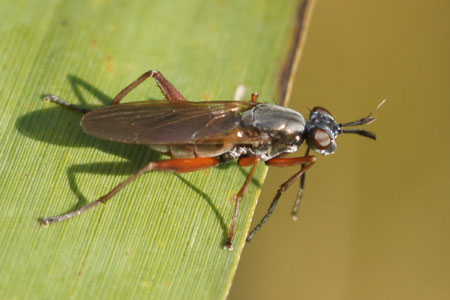 .. ..
 Sepedon sphegea.
Family Sciomyzidae. Sepedon sphegea.
Family Sciomyzidae.
The head, thorax and abdomen are dark grey, blackish. De femurs
are orange red. Length 8 - 11 mm. April - October. Photos 7-10-2013 (in
the dunes) en 12-3-2018 (In the garden blowing a bubble). |
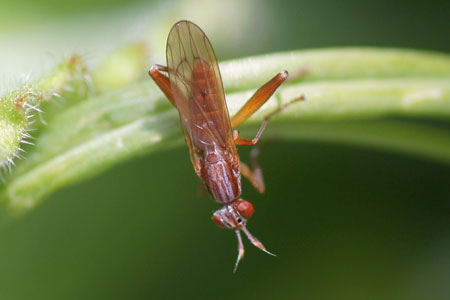 .. ..
 . .
 Sepedon spinipes.
Family Sciomyzidae. Sepedon spinipes.
Family Sciomyzidae.
Spinipes because it has spines on the thighs. A much slimmer
fly than the Tetanocera. Length about 8 mm.
Photos 04-04-2011, 19-4-2013. |
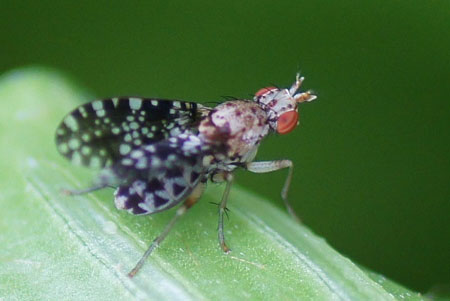 .. ..
 Trypetoptera punctulata. Family
Sciomyzidae. Trypetoptera punctulata. Family
Sciomyzidae.
Because of the patterned wings is often thought that it is a
peacock fly. Length 6-7 mm. May - October. Palearctic. Photos 19-6-2014. |
Horse-flies, gadflies ( Tabanidae).
In our garden we almost never see a gadfly. The fly feeds on nectar and pollen. The female sticks and then sucks blood from humans and animals. It needs
blood for the eggs to develop. The larvae are aquatic, semi-aquatic or terrestrial and
feed on other invertebrates such as worms, snails and other Diptera larvae, including their own species.
(translated text Pjotr Oosterbroek) There are about 38 species in the Netherlands. A horse-fly has no arista on the antenna.
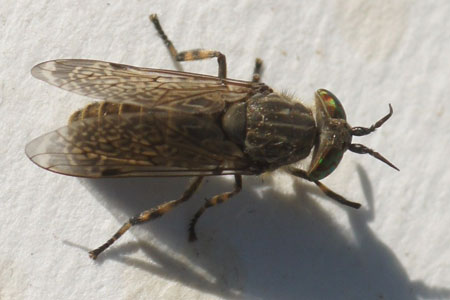 .. ..
 . .
 Horse Fly (Haematopota). Family Horse-flies, gadflies
(Tabanidae). Female. Horse Fly (Haematopota). Family Horse-flies, gadflies
(Tabanidae). Female.
In the Netherlands there are several similar
species. Haematopota crassicornis, Common Horse Fly or Notch-horned Cleg Fly
(Haematopota pluvialis), Haematopota subcylindrica, Haematopota italica. Rarer:
Haematopota scutellata and Haematopota bigoti.
Already the second horse fly in the garden this year. I was stabbed twice in my arm.
An hour later I saw it in the scullery. I could take a picture before it flew away.
A week later I was stabled in my leg. I've taken a photo of this horse
fly. This horse fly is identifiable by the zigzag lines on the brightly
coloured eyes and the spotted pattern on the wings. Those wings are folded
roof-shaped over the body.
The length of this horse fly was about 11 mm.
Photos 9-8-2012, 18-8-2012. |
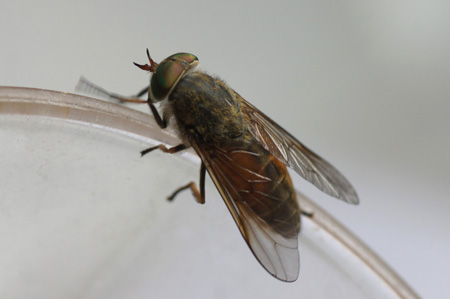 .. ..
 . .
 . .
 Levels
Yellow-horned horsefly (Hybomitra solstitialis synonym Hybomitra ciureai). Family Horse-flies, gadflies
(Tabanidae). Female. Levels
Yellow-horned horsefly (Hybomitra solstitialis synonym Hybomitra ciureai). Family Horse-flies, gadflies
(Tabanidae). Female.
The abdomen is orange yellow on the side. Orange antennae.
It looks like the Hybomitra muehlfeldi.
Length 14-17 mm.
May - September.
Europe, Asia to China, Mongolia. Photos 26-7-2017. |
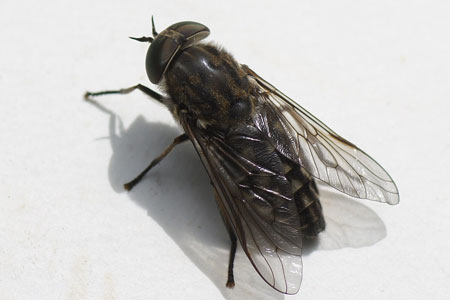 .. ..
 . .
 . .  Female. Female.
 Male.
Large marsh horsefly (Tabanus
autumnalis).
Family Horse-flies, gadflies (Tabanidae). Female. Male.
Large marsh horsefly (Tabanus
autumnalis).
Family Horse-flies, gadflies (Tabanidae). Female.
A large gray fly. On the abdomen are light triangular spots. But more
horse-flies have triangular spots. The sharp mouth parts are visible in
the left pictures.
It looks like the band-eyed brown horsefly (T. bromius) and pale giant horse-fly
(T. bovinus).
Length about 20 mm.
April - September. Europe, North Africa, the Middle East and Western Asia.
Photos 29-6-2012,
24-6-2016.
|
Stiletto flies (Therevidae)
They are mostly hairy flies.
Ulidiidae
The wings have a pattern of spots or a spot at the top of the wing.
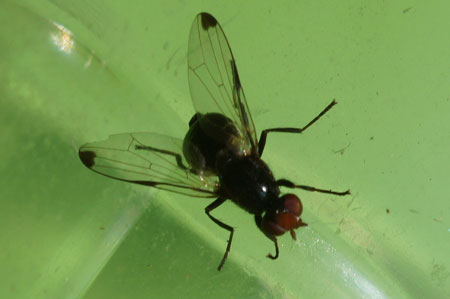 .. ..
 . .
 Seioptera
vibrans. Family Ulidiidae.A shiny dark fly with a prominent spot on the wings. It looks like a Lesser dung fly. You can find the larvae in manure and decaying material. Length 5 to 6 mm. May-September. Photos 3-7-2010. Seioptera
vibrans. Family Ulidiidae.A shiny dark fly with a prominent spot on the wings. It looks like a Lesser dung fly. You can find the larvae in manure and decaying material. Length 5 to 6 mm. May-September. Photos 3-7-2010. |
Entomophthoraceae
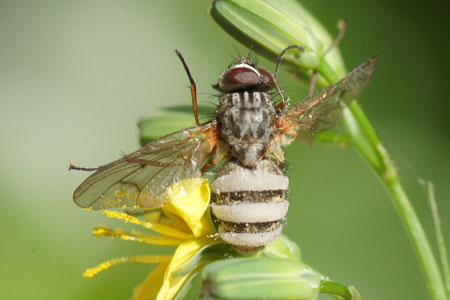 Entomophthora cf
muscae. cf: very probably but there are more species of Entomophthora. Familie Entomophthoraceae. Entomophthora cf
muscae. cf: very probably but there are more species of Entomophthora. Familie Entomophthoraceae.
With countless enemies flies don't have an easy life. This fungus is also deadly. I placed it on the fly page, because many people think that it is a special kind of fly with these white bands.
All kinds of flies can suffer from it. This is a Phaonia family house flies (Muscidae). The Dungfly (Scathophaga) you also frequently see with this fungus.
The fungus grows also inside the fly. If it reaches the brains, it affects the behavior of the fly. Shortly before its death the fly crawls to a high point. As a result, the spores can be better spread. The belly (abdomen) swells, the legs and wings are spread. Around the abdomen, you see the white bands. |
I want to thank everyone, who has helped me (waarneming.nl)
to identify. In particular, Joke van Erkelens, Robert Heemskerk, Mark van Veen,
Gerard Pennards, Niels-Jan Dek and Han Endt. With the determination of Tachinidae I have had
much help from Theo Zeegers and Chris Raper.
Nederlands /
Dutch
 
Subpage flies:
Tachinidae
Blow-flies
(Calliphoridae) House
flies (Muscidae) Soldierflies
(Stratiomyidae)
Root-Maggot
Flies (Anthomyiidae)
Small
flies Gnats
Subpage wasps, bees, bumblebees: Parasitica, Ichneumonidae
Sawflies
symphyta Bumblebees
Bee hotel
Subpage France: Insects
France
|
